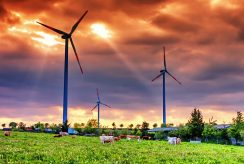It is indisputable that the energy demand is growing at a rapid pace on a global scale. This has resulted in different methods, and solutions being developed to curb the high demand. Some of the visibly effective ways are; solar and wind energy. Since 2010, wind energy has experienced immense growth with off-shore wind farming increasing in generation by nearly 30% each year. Though wind has been an essential energy source, off-shore wind farms still haven’t been exploited to their full potential. As the UN predicts that there will be almost 10 billion people on earth, the demand will continue growing, and so is the need for continued innovation.
This article will discuss some of the benefits of off-shore wind farming.
REDUCED POLLUTION
Wind farming is a renewable energy source that reduces air pollution by replacing the more polluting energy source with wind-generated power. This helps in reduced emissions of sulfur dioxide, nitrogen oxides, and carbon dioxide. Wind turbines have been known to produce a lot of noise as they operate. Since off-shore turbines are in the oceans and seas and away from residential areas, people are not affected by the noise.
MORE SUSTAINABLE GRID POWER
Being located in the oceans and sea, off-shore wind farms will experience 40 % more winds that are consistent than land wind turbines. This is because the ocean is flat, and the wind does not encounter obstacles such as buildings, hills, valleys trees that end up blocking the wind speeds. Off-shore wind turbines are then able to generate a lot more power as compared to other on-shore turbines.
REDUCED RISK TO WILDLIFE
On-shore wind turbines contribute to wildlife casualties as birds, and other species tend to get caught up in the blades resulting in death. The offshore wind turbines do not pose such risk as they are located in the sea and rarely do birds go out to sea. It has been found that the bases of the wind turbines have been growing areas for algae hence sustaining schools of fish and keeping the aquatic food chain alive.
SAFETY
On-shore turbines may pose a risk to civilization as technical issues may end up affecting people in the vicinity. As the population keeps surging, the lands used by on-shore turbines will increasingly be filled hence increasing the risk of fatalities in case of an incident. Off-shore turbines being in the water minimize risk to humanity. Also, what brings about safety is the turbines’ design and construction as they are constructed on systems such as a monopile to hold them in place and secure them to the ground and keep the turbines safe from falling due to ocean tides.
SPARED NATURAL RESOURCES
One of the main advantages of off-shore wind farming is that it does not need vast land for construction. Trees will not need to be cut down, and people do not require to relocate. Off-shore farms are being constructed away from marine life habitats.
It is clear that wind power is increasing in popularity worldwide, and the technology becomes sustainable as global policies target climate change. Many countries tied to the traditional forms are rallying to grow their green electricity infrastructure.
